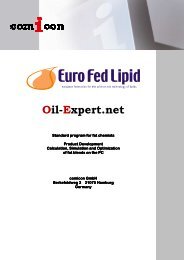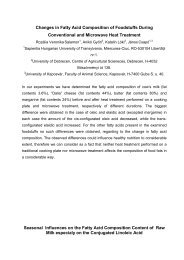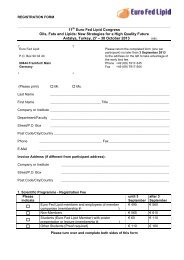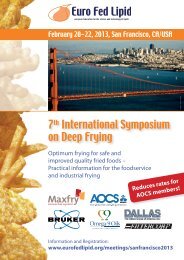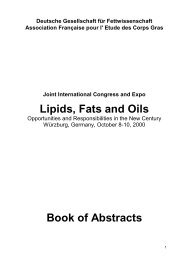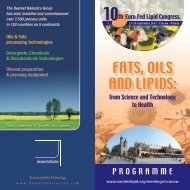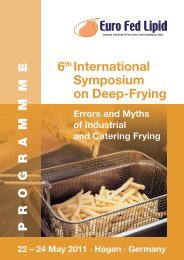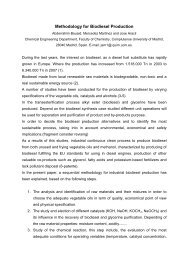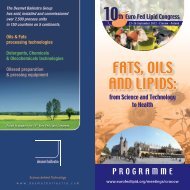Abstracts now available online - Euro Fed Lipid
Abstracts now available online - Euro Fed Lipid
Abstracts now available online - Euro Fed Lipid
Create successful ePaper yourself
Turn your PDF publications into a flip-book with our unique Google optimized e-Paper software.
Molecular basis for the elicitation of plant innate immunity by lipooligosaccharide<br />
of Xanthomonas campestris<br />
Mari-Anne Newman $ , Gitte Erbs $ , Antonio Molinaro * , Alba Silipo * , Luisa Sturiale ‡ , J.<br />
Maxwell Dow § , Rosa Lanzetta * , Michelangelo Parrilli *<br />
$<br />
Royal Veterinary and Agricultural University (KVL), Frederiksberg, Denmark.,<br />
*Università di Napoli, Italy. ‡ Istituto per la Chimica e la Tecnologia dei Materiali<br />
Polimerici - ICTMP – CNR, Catania, Italy. §BIOMERIT Research Centre, Cork, Ireland.<br />
Lipopolysaccharides (LPSs) and lipooligosaccharides (LOSs) are major components of<br />
the cell surface of Gram-negative bacteria with diverse roles in bacterial pathogenesis<br />
of animals and plants that include elicitation of host defences. Little is k<strong>now</strong>n about the<br />
mechanisms of perception of these molecules by plants and about the associated signal<br />
transduction pathways that trigger plant immunity. We have addressed the issue of the<br />
molecular basis of elicitation of plant defences through the structural determination of<br />
the LOS of the plant pathogen Xanthomonas campestris pv. campestris strain 8004 and<br />
examination of the effects of LOS and fragments obtained by chemical treatments on<br />
the immune response in Arabidopsis thaliana. The structure shows a strong<br />
accumulation of negatively charged groups in the lipid A-inner core region and has a<br />
number of novel features, including a galacturonyl phosphate attached at Kdo residue<br />
and a unique phosphoramide group in the inner core region. Intact LOS and the lipid A<br />
and core oligosaccharides derived from it were all able to induce the defence-related<br />
genes PR1 and PR2 in Arabidopsis and to prevent the hypersensitive response (HR)<br />
caused by avirulent bacteria. Although LOS induced defence-related gene transcription<br />
in two temporal phases, the core oligosaccharide induced only the earlier phase and<br />
lipid A only the later phase. These findings indicate that plant cells can recognize lipid A<br />
and core oligosaccharide structures within LPS to trigger defensive cellular responses<br />
and that this occurs via two distinct recognition events.




